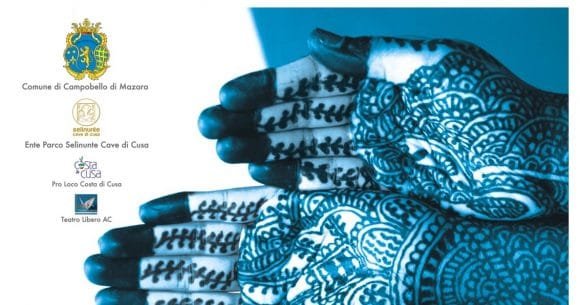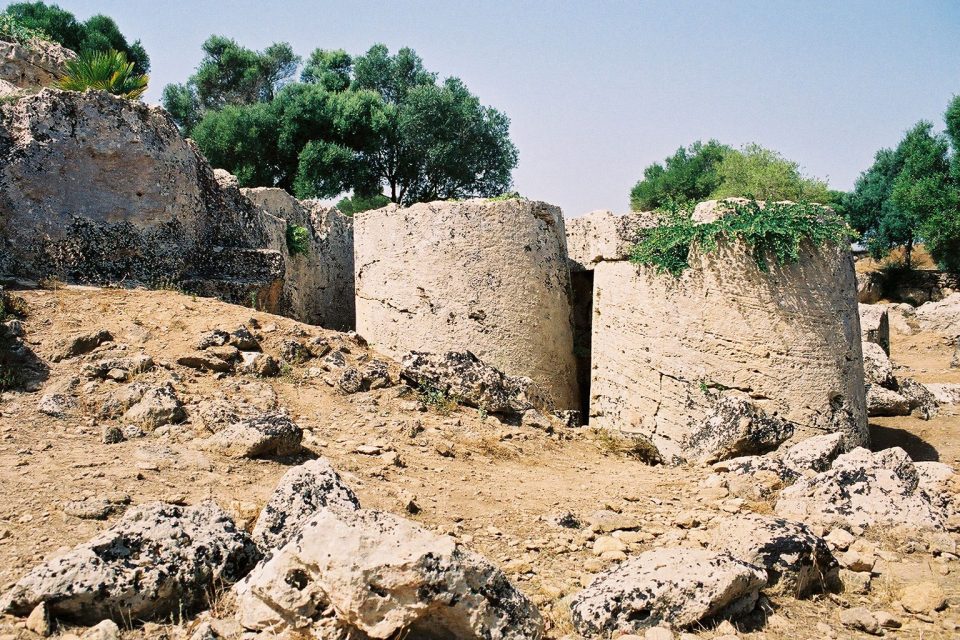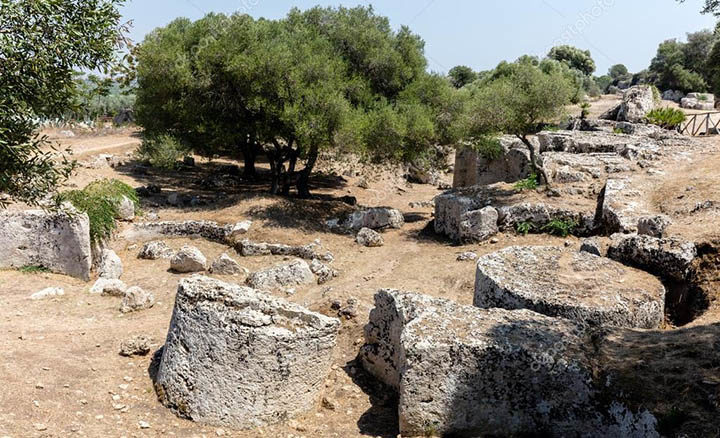Cave di Cusa, Latomie e Cave Misilbesi, such evocative places! We can’t end our trip to Selinunte without visiting them, at least the biggest and most popular Cave di Cusa.
Sculptures in Selinunte temples
Selinunte is the only Greek city in Sicily where the temples had decorations provided with sculptures. Mainly they used calcarenites and marbles as main types of materials. Mostly they would carry marbles for the metopes from quarries near their city.
Anyway the marble they used for the small sculptures and the nude female parts of the metope seems not to have been sicilian.
In fact, at Capo Granitola, they have found wrecks of Roman ships which transported blocks of marble. These marbles probably came from the Cyclades and the western coasts of Anatolia, some from Aphrodisias and from an area near Ephesus, currently in Turkey.
Cave Misilbesi
The main stone extraction site that Greeks used for the sculptures and friezes adorning the temples of Selinunte was “Cave Misilbesi”, visible along the road connecting Palermo to Sciacca.
The quarry consists of a gigantic block of calcarenite, a sedimentary rock of marine origin formed in the Pliocene. Basically, this is tuff, or lapilli issued during volcanic eruptions, mixed with other material, often marine shells.
The rock quality, compact and at the same time soft and crumbly, is excellent. It is possible today to visit part of these quarries within the Feudo Arancio winery.
The Latomie Quarry
In Latomie district, about 5 km from Selinunte, there is still a quarry where the inhabitants of Selinunte would take the calcareous tuff used for the construction of the oldest temples. A wooden drum of a column, already cut, is well visible in it. Tuff coming from Latomìe district was friable and yellowish in color and in smaller blocks. The one coming from Cusa quarry was solid, compact and paler in color. Today evocative olive and citrus groves, in a typically Sicilian setting, cover and surround the cave area.
CAVE di Cusa
Instead, the stones for the construction of the more recent temples and for G temple in the current archeological park of Selinunte, came from the Cave di Cusa.
Cave di Cusa is a quarry, about 13 km from Selinunte, near Campobello di Mazara. The name of the site refers to an old owner of the area, Baron Cusa. The Sicilian Government has dedicated the Cave to the archaeologist Vincenzo Tusa. Thanks to him, in the last century, excavations in the archaeological sites of Solunto, Segesta, Selinunte, Mozia, Marsala had a great beginning.
Here at the Caves, the work had to cease abruptly, probably due to the arrival of Hannibal in 409 BC. Workers left columns, capitals and elements of architrave on the ground in different stages of processing.
The stone processing
The Cave di Cusa are very large and in excellent condition. This allows the analysis of all the phases of stone processing.
Without the proof of those stones we would hardly have understood the technical capacity and the tenacious search for perfection that animated the Selinunte artists.
Cave di Cusa is the closest point to Selinunte where the calcarenite bench is compact and massive. It offered the Selinuntians the possibility of detaching elements as large as those of the temple G.
The pieces, after having been almost entirely carved into the rock, were detached from the rock thanks to the work of wooden wedges expanded by water.
Even today it is possible to notice some U-shaped furrows in the blocks, due to the ropes used to lift them. It is possible to see holes at the two ends of the column, where they fixed pins to facilitate movement and installation.
The Punic conquest, which took place in just a few days, led to the sudden interruption of the work at the quarry. The pieces were abandoned. Some were just rough-hewn, others were ready and others already travelling towords the destination.
Punicians no longer needed them because their architectural constructions were rather simple. Moreover, the old Selinunte itself became the area from where Punics would take the material for their constructions.
such an artistic place!
Art on stage at the Cave di Cusa. Among the quarries history teaches us its message for a more conscious future.
In the enchanting setting of Cave of Cusa an artistic festival was performed in summer 2018. Imagine a theatre among the column spindles cut out in the rock.
“A ventu … Abbentu” is his name, directed by the Sicilian writer and philosopher Giacomo Bonagiuso. He has dedicated his life to theater as a moment of growth for future generations.
Mythodea
Mythodea has opened the festival. The show under the stars tells us how every civilization comes from an “exodus”, a “migration” from its root, whether it is a mother country or a family group. The story was the same even in Selinunte, born thanks to the migration of a large group of settlers from Megara. So this show helps us to read the history to tell the present: the new migrations and the new exodus that still live in Sicily.

There could be no better place, if we want to contact our roots. If we want to talk of beauty. The Cave di Cusa is the largest open-air factory of beauty. Here, in each of those rock-cut boulders, the Greek soul is still hidden but alive.
Photo: https://www.siciliafan.it/cave-cusa-storia-greca-provincia-trapani-sicilia/

